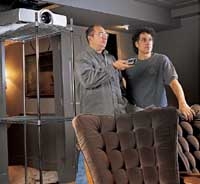My Digital Adventure

When we last visited director Barry Sonnenfeld (February/March 2004), he was a man without a home theater. Having sold his house in Amagansett, New York, and not yet ready to move to Telluride, Colorado, he had to watch DVDs in the screening room at his East Hampton, New York, offices. Barry has since settled into a house in East Hampton as he awaits his move to Colorado. Here he tells how setting up a home theater in his interim abode unexpectedly gave him a glimpse of cinema's future.
Accidentally selling our home in Amagansett four years before we intended to move to Telluride, I found myself living in a house with a huge basement that had the potential to be a home theater. The screening room in my old house was designed for 35mm film projection. The movies I directed had been edited in East Hampton, and we would often look at the work in progress in my home theater. Movies like Men in Black and Wild Wild West had hundreds of optical effects shots that we would screen for contrast, color, and sharpness. The room also had an analog Sony video projector - a great CRT model with 9-inch tubes.
The last film I directed, Men in Black II, although shot on film, spent most of its life in the digital world. The film dailies were transferred to video and then edited digitally (as almost all films are, with the exception of Steven Spielberg's - Steven still insists on editing on film). All of our recruited-audience screenings - where we invite three hundred people who don't know how to spell to watch our movie and comment on it - were projected digitally. It wasn't until we had finished the project that we cut the negative and made film prints for the theaters. I was also getting sound mixes in Dolby Digital surround sent to me over the Internet, which were then downloaded to my computer and synced to the film projectors for viewing.
When I was in Los Angeles directing MIB II in 2001, Texas Instruments set up a demo of its latest digital projector in a local theater. The image was extraordinary - the only thing missing was the projector flicker we're used to seeing in movie theaters. I could tell that a change was quickly coming. When it came time to build a theater in my new home, I realized that the future was digital and that 35mm projection was no longer needed for either my work or my viewing pleasure.
Although the Sony CRT projector I had in the old house produced a beautiful image, it needed biyearly tweaking, and I really wanted to see what a 16:9 high-def digital proector could do. I interviewed several installers and hired the amusing, talented, and often ill John Tamburello. He drives a car that most junkyards would reject for not having enough panels worth scrapping. On the other hand, he says he doesn't worry about its being parked on the streets of New York City. He seems to live on pizza and cold coffee, and always exhibits flu-like symptoms, but is strangely very smart, informed, and easy to work with.
 The first decision we had to make was the size of the screen. I wanted a microperforated screen so the front left, center, and right speakers could be located behind it. I also wanted a fairly large image, even though the room is only 18 x 24.5 feet. We went with a 12-foot-wide screen, which Sweetie the wife thinks is too big and I think verges on too small. Because our room is located in a dedicated space without windows, we had 100% control over the room's ambience and were able to go with a relatively bright (1.3 gain) white screen. (Some projector manufacturers suggest using a lower-gain gray or silver screen in rooms that can't be completely darkened to help create the illusion of deeper blacks, since grayish blacks have been one of the drawbacks of DLP projectors.)
The first decision we had to make was the size of the screen. I wanted a microperforated screen so the front left, center, and right speakers could be located behind it. I also wanted a fairly large image, even though the room is only 18 x 24.5 feet. We went with a 12-foot-wide screen, which Sweetie the wife thinks is too big and I think verges on too small. Because our room is located in a dedicated space without windows, we had 100% control over the room's ambience and were able to go with a relatively bright (1.3 gain) white screen. (Some projector manufacturers suggest using a lower-gain gray or silver screen in rooms that can't be completely darkened to help create the illusion of deeper blacks, since grayish blacks have been one of the drawbacks of DLP projectors.)
Our theater was designed with a soffit running across the back of the room that sends cool, fresh air across the enclosed projector. I didn't want to hear the fan of a projector during screenings, and although this was quite an expensive architectural detail, it was worth it, since it also isolates the projector from cigar smoke. The cigars created additional expenses due to the installation of industrial-strength smoke eaters as well as a variably controlled ozonator to kill any smoke odors.




























































